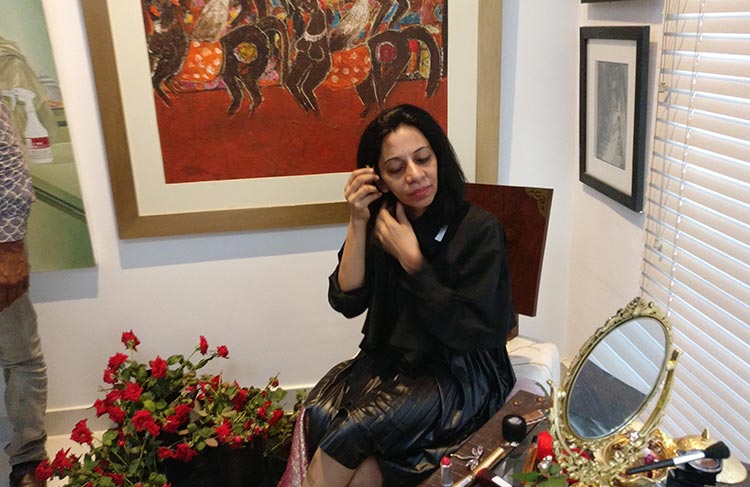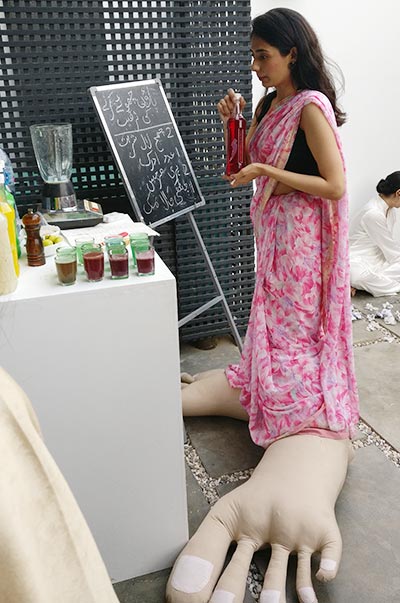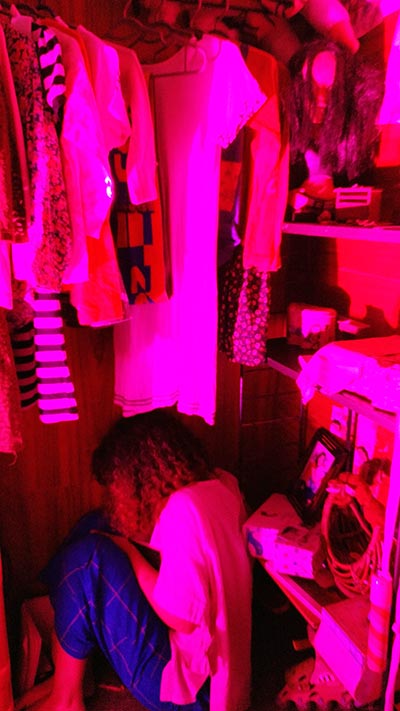The Body As Medium: Mix Tape [1] at Canvas Gallery
Performance art, while gaining considerable traction in Pakistan, is still a rarity, with very few artists dabbling in it exclusively. However, in recent years there have been a number of shows focusing solely on performance art. The inaugural Karachi Biennale also focused heavily on performances, providing artists with the means to explore its depths and limits on viable platforms. A recent show, “Mix Tape [1]” at Canvas Gallery, curated by Sarah Pagganwala, was another such project, immersing the audience in an array of performative works taking place simultaneously. As audiences swarmed into the packed gallery space, to observe some 24 performances in a one-day event, the need for more events promoting alternative forms of display became painfully evident.
One of the first works the audience came across was performed outside by Emaan Mahmud, Pretty Art for Pretty People, which included a reading of a satirical piece authored by the artist about the Karachi Biennale ’17 from the perspective of a fictional character, Champa. The work was a self-referential piece that explored the very issues surrounding performance art, and its inability to satisfy the aesthetic sensibilities and expectations of the art consumer, making it an apt opening to the show.
The performances beyond took on a number of forms, some carried out in repetitive symbolic acts, where the performance became almost a meditative experience for the artist, such as Burnt/Unburnt by Noor Ahmed, Once and For All by Amna Khan, and … by Sana Nasir. Others, using an interactive format, invited the audience to become part of the performance. These works were somewhat along the lines of Yoko Ono’s Cut Piece (1964), and in a way left the artists vulnerable and at the audience’s mercy. Amin Gulgee lay in his undergarments under a sign “Paint Me,” and audiences were welcome to paint his body as they liked. Muhammad Ali (Mirchi) stood in a form fitting body suit, giving the audience the power of the sculptor, and inviting them to “mould” him as they wished, directing his positions and postures.
Some of the other works appeared a lot more deliberated and choreographed, with props and designed spaces within which they were performed. A few of these focused on the expectations placed on women’s bodies and the anxieties thus created. Noreen Ali Parpia stood dressed in an elegant saari, wearing impossibly large foam feet, demonstrating the remedy for this predicament. Sarah Mumtaz sat beside a mirror with beauty products and jewelry, and a bucket of roses, inviting the audience to beautify her and handing them roses in return. At a certain point, she even covered her face with a sack which had an embroidered face on it. Fatima Zara Mallick worked herself to exhaustion, hysteria and self-harm, amidst gym equipment, for the sake of the perfect body. These works commented on the impossible and unnecessary beauty standards that women are meant to adhere to, the insecurities they fester, and the lengths women go to for the benefit of others.
The works that stood out the most, however, were the ones that forced the audience to feel uncomfortable as they confronted uncomfortable truths. One of the most striking works was by Sana Jafri, who transformed a narrow corridor and a bathroom into a haunting space full of personal effects, stuffed animals, clumps of hair and assorted paraphernalia. Eerie sounds of trickling water filled the darkened room as she cowered in a corner, scared and crying. The entire scene seemed to be the product of a nightmare, emerging from a very dark and traumatic place in the artist’s mind, and calling to unmentionable experiences. The very act of walking through the space seemed like a reenactment of the violation and possible loss of innocence the piece sought to portray, as the artist hid her face and shrunk further away at the audience’s approach. Maha Minhaj and Zoya Alina Currimbhoy, on the other hand seem to talk about the post-colonial experience and the process of decoloniality. As Minhaj sat and tore off her colonial attire with her teeth, Currimbhoy proceeded to try (and fail) to erase harsh realities of colonial India with pills and a paint roller, portraying the dual reactions of the colonizer towards their history; aggressive guilt and denial. It may also portray the condition of the colonized, aggressively rejecting and attempting to shed all remnants of a colonial past, while trying and failing to overwrite history, to heal and move forward with an independent identity. Anusha Khalid’s piece was an expressive portrayal of life itself, and resilience in the face of failure, yet the choice to use a male tormentor, added overtones of domestic abuse that made the audience rather uneasy.
The success of some performances was not in what they were attempting to portray, but in the emotions that they were able to elicit in the viewer. This is a rather subjective space, as certain issues resonate more with certain viewers due to their own experiences, sometimes in ways not even intended by the artist. “Mix Tape [1]” was a pleasant reminder of the ability of performance art to express ideas through the body and its actions, in ways that the conventional art forms fail to, making it one of the most effective mediums of art production today.
Written by: Nimra Khan – Posted on: September 18, 2018
Source: youlinmagazine.com






